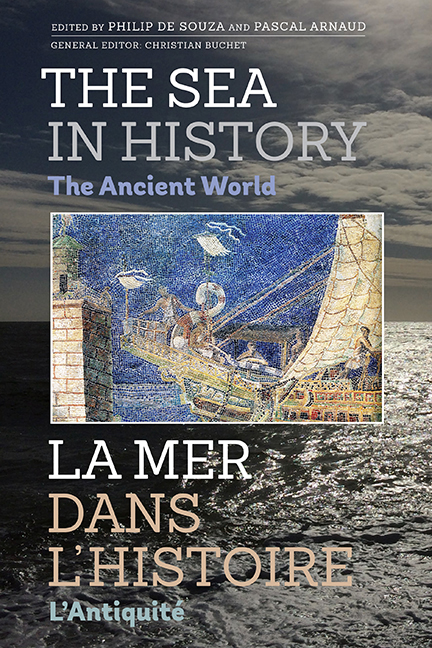Book contents
- Frontmatter
- Contents
- List of Illustrations
- List of Contributors
- Introduction générale et remerciements par Christian Buchet
- General introduction and acknowledgements
- Introduction (français)
- Introduction (English)
- La mer est le propre d'Homo sapiens
- PREHISTORICAL CASE STUDIES
- Maritime aspects of early Andean civilizations
- Une approche maritime et archipélique de l'occupation amérindienne des Antilles
- The Taíno of the Caribbean: six thousand years of seafaring and cultural development
- The importance of the sea for prehistoric societies in Western Europe
- Pêche et interactions entre la Moyenne Vallée du fleuve Sénégal et le littoral atlantique Sénégalo-Mauritanien durant le dernier millénaire BC
- The sea and early societies in the Japanese Islands
- Développement maritime de la civilisation océanienne
- HISTORIAL CASE STUDIES: The Ancient Near East and Pharaonic Egypt
- HISTORICAL CASE STUDIES: The Mediterranean world
- HISTORICAL CASE STUDIES: The Indian Ocean and the Far East
- Conclusion (français)
- Conclusion (English)
- Conclusion générale par Christian Buchet
- General conclusion
- Comprendre le rôle de la mer dans L'histoire pour éclairer notre avenir
- Understanding the role the sea has played in our past in order to shed light on our future!
Maritime aspects of early Andean civilizations
from PREHISTORICAL CASE STUDIES
Published online by Cambridge University Press: 20 April 2017
- Frontmatter
- Contents
- List of Illustrations
- List of Contributors
- Introduction générale et remerciements par Christian Buchet
- General introduction and acknowledgements
- Introduction (français)
- Introduction (English)
- La mer est le propre d'Homo sapiens
- PREHISTORICAL CASE STUDIES
- Maritime aspects of early Andean civilizations
- Une approche maritime et archipélique de l'occupation amérindienne des Antilles
- The Taíno of the Caribbean: six thousand years of seafaring and cultural development
- The importance of the sea for prehistoric societies in Western Europe
- Pêche et interactions entre la Moyenne Vallée du fleuve Sénégal et le littoral atlantique Sénégalo-Mauritanien durant le dernier millénaire BC
- The sea and early societies in the Japanese Islands
- Développement maritime de la civilisation océanienne
- HISTORIAL CASE STUDIES: The Ancient Near East and Pharaonic Egypt
- HISTORICAL CASE STUDIES: The Mediterranean world
- HISTORICAL CASE STUDIES: The Indian Ocean and the Far East
- Conclusion (français)
- Conclusion (English)
- Conclusion générale par Christian Buchet
- General conclusion
- Comprendre le rôle de la mer dans L'histoire pour éclairer notre avenir
- Understanding the role the sea has played in our past in order to shed light on our future!
Summary
ABSTRACT.This contribution assesses the latest archaeological evidence for the exploitation of maritime resources by human settlers on the Andean coast of South America. It discusses the extent to which the earliest civilizations of the central Andean region, which flourished c. 3800–1650 BC, depended upon marine resources and considers the importance of fishing and maritime commerce for later Andean societies up to the Spanish conquests of the 16th century AD.
RÉSUMÉ.Cette contribution analyse les dernières découvertes archéologiques de l'exploitation des ressources maritimes par l'être humain sur la côte andine d'Amérique du Sud. Elle étudie dans quelle mesure les civilisations primitives de la région des Andes centrales, qui ont prospéré de c. 3800 à 1650 av. J.-C., ont pu dépendre de ressources marines. Elle réfléchit également à l'importance de la pêche et du commerce maritime chez les sociétés andines plus récentes, jusqu'aux conquêtes espagnoles du 16ème siècle ap. J.-C.
The sea and its resources have played a critical role in the settlement and cultural development of the central Andean region, from the first arrival of humans more than 14,000 years ago through the long span of prehistory and into historic and modern times. This is no surprise – the coast of western South America is one of the world's richest fisheries thanks to upwelling associated with the Humboldt Current that flows north from Antarctica. From the start, Andean peoples have made sophisticated use of maritime resources.
The central Andean region (Figure 1) includes the southern coast of Ecuador, the coast of Peru, and the northern coast of Chile. The entire region is one of the world's driest deserts thanks to the rain-shadow effect of the Andes mountains to the east and the influence of the cold Humboldt Current to the west. Natural and human life, even large populations, are possible in this region because of two factors: the rivers that flow west from the Andes to the shore and the richness of the ocean. The river valleys tend to run perpendicular to the shoreline, creating T-shaped human settlement patterns. Farming is possible only in the valleys and their deltas, where irrigation canals can reach.
- Type
- Chapter
- Information
- The Sea in History - The Ancient World , pp. 41 - 54Publisher: Boydell & BrewerPrint publication year: 2017



